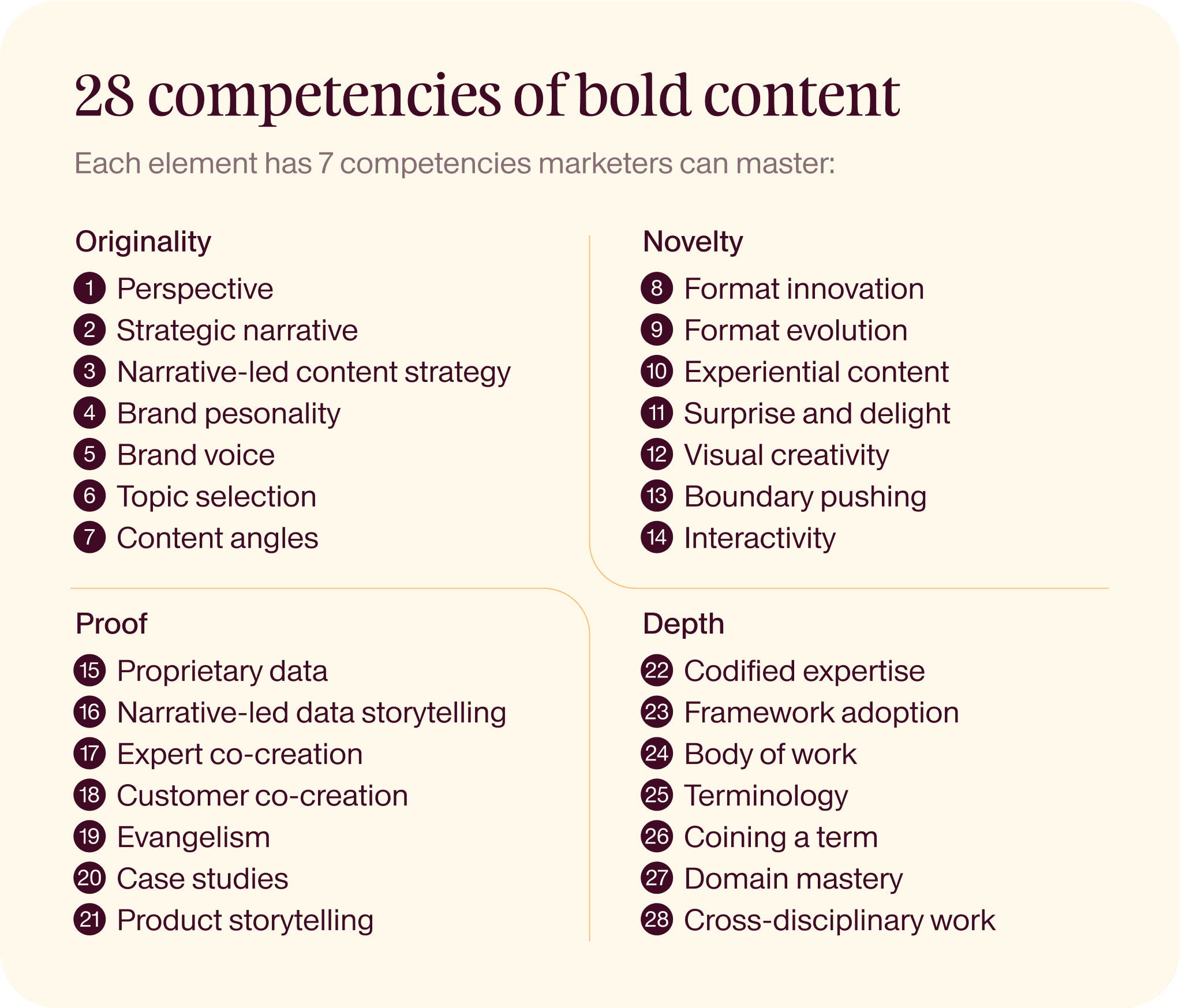How to Create Bold Content Like Erin Balsa
Bold content is the difference between forgettable and unforgettable marketing. In this Relato special edition, Erin Balsa breaks down her 5-step framework to help content teams define, assess, and consistently create content that truly stands out.

This week, we’re doing something different. Instead of another playbook from us, we sat down with one of the best in the game: Erin Balsa.
Erin Balsa has helped dozens of content teams create work that truly stands out and inspired thousands more along the way.
She’s the OG of bold content.
And she just walked us through exactly how she does it.
In one interview, Erin completely reshaped the way we think about evaluating content.
(Seriously. Could not take notes fast enough.)
Her framework gave us the language to name what’s missing in most content — and a clear path to fix it.
If you want to create content that stands out in 2025, you really, really need to read this.
1. Define what bold content actually means to your team
You can’t be bold if no one agrees on what bold actually is.
That’s how you end up with content that starts out punchy and unique, but gets watered down through round after round of reviews.
“People say, ‘Oh, we want to be bold,’” says Erin. “But then…they’re really not that bold. There’s usually a couple of reasons why, but it all boils down to the fact that they don’t have an agreed-on definition of what it looks like to be bold. So they’re running at it in different directions.”
““People say, ‘Oh, we want to be bold,’” says Erin. “But then…they’re really not that bold. There’s usually a couple of reasons why, but it all boils down to the fact that they don’t have an agreed-on definition of what it looks like to be bold. So they’re running at it in different directions.” ”
Every team needs to have the conversation: What does bold mean for us?
What are our creative guardrails? What are we trying to emphasize?
Because when they skip that step on your journey to bolder content, Erin sees teams falling into one of two traps:
- Camp Copycat — mimicking “sassy” brands and coming off like an “unhinged millennial HR director”
- Camp Virality — chasing attention with stunts that feel disconnected from the brand (think: "let’s have our podcast guests eat hot wings")
Bold content doesn’t mean reinventing who you are. It means turning up the volume on what already makes you great.
As Erin puts it, every company has a “brand essence”. It might live in your Slack channels, your origin story, your tone, or your culture — but it’s the stuff your happiest customers and employees already recognize about you.
Bold content simply emphasizes that essence.
Think bold font, not bold reinvention. You’re not rewriting the message in wingdings. You’re just making it stand out.
So, Step 1 is to articulate what makes your company unique — the story that only your brand can tell. That’s the foundation of your new, bolder content.
2. Use Erin’s Bold Content framework to assess where you are
Next, it’s time to take a clear-eyed look at your existing content.
Erin has defined “four elements of bold content”:
- Originality — the distinctiveness of your perspective and brand personality
- Novelty — the creative wow factor of your formats and your visuals
- Proof — the credibility of your claims and solution
- Depth — the sophistication of your ideas and body of work
Take a look at the content you’re currently creating, and evaluate it against each of these factors.
Here are a few questions to get you started.
Questions from Erin’s Content Assessment:
Originality:
- Do you have a distinctive perspective about your industry that challenges conventional wisdom and sets you apart from your competitors?
- Are you addressing questions, problems or opportunities that your competitors aren't discussing yet?
Novelty:
- Have you reimagined a standard content format like blog, white paper, case study with a fresh approach?
- Within the last year, have you executed a non-traditional campaign that surprised and delighted your audience?
Proof:
- Do you collaborate with customers to create content that demonstrates how they use your product (outside of creating case studies)?
- Have you received third party validation, like analyst report certifications or awards that reinforce your credibility? If yes, have you shared them in your content?
Depth:
- Have you codified your expertise as a one of a kind discipline, framework or methodology others can use to work better?
- Have you coined a term that your audience has adopted or responded positively to?
All four elements need to be present for your content to stand out and influence buying decisions.
But it’s important to note that Erin’s 4 elements all exist on a spectrum — and you don’t need to max out every one of them to be successful.
In fact, you probably shouldn’t. Because the right level of each of the four elements will depend entirely on your customers and your product.
Which brings us to the next step…
3. Deeply consider your market and what their content needs are
As Erin explains, the right balance of the four elements will depend on your business model and audience.
“If you're selling to the Fortune 100 and your annual ACV is $300,000, you probably don’t need to worry as much about novelty. What you do need is a lot of proof and depth — because you’re selling to a large buying team, and they need to trust you.
On the other hand, if you’re product-led and selling something like Calendly, you need wide adoption. You need some virality. You might not need as much depth — but you do need a lot more novelty and originality to get people talking and emotionally connecting with your brand.”
Bold doesn’t look the same for every company. Your job is to figure out which levers matter most to your audience — and start dialing those up.
“Bold doesn’t look the same for every company. Your job is to figure out which levers matter most to your audience — and start dialing those up.”
4. Use the 28 content competencies to level up your strategy
Each of the four elements — originality, novelty, proof, and depth — breaks down into specific, practical competencies.
Erin’s identified 28 of them to help you spot exactly where your content is falling short (and what to work on next).

Originality is the one to start with.
“Originality is the foundation for the other three elements,” Erin told us. “You have to build that first — your perspective and your brand personality — and then the other elements help you to stand out while building trust and authority.”
If your content sounds like it could’ve come from any brand in your category, begin there.
Then move on to the rest:
Are your formats fresh? Is your proof strong? Are your ideas deep enough to resonate with senior decision makers?
You don’t need to overhaul everything at once. Just pick a few areas where you're weak — maybe your format choices are stale, or you're light on credible proof.
This approach turns “make the content better” from a vague command into something tactical and achievable. And over time, those small, focused improvements add up to a content strategy that’s far more cohesive, confident, and bold.
5. Finally, make sure you don’t fall back into bad habits
Erin has found that bland content is usually a symptom of a deeper issue.
“The real issue is almost always that you have people problems or process problems.”
“The real issue is almost always that you have people problems or process problems.”
If senior leaders are stepping in to handle basic editorial tasks, or you hear yourselves saying things like, “This looks like my 8 year old wrote it, we can’t publish this,” chances are you’ve got a people problem like:
- Junior content leads — or no content lead
- Overworked demand gen or product marketing leaders “own” content — but they don’t have time to manage day to day operations
Solution:
You need to bring on a dedicated content lead. That might mean carving out the role within your existing team or bringing in outside support.
Even on a tight startup budget, Erin says that a few hours a week with a fractional Head of Content can make a huge difference — helping you set a direction, coach your writers, and start telling a more cohesive story.
On the flip side, if you feel like your content is fragmented, and you’re just going “Let’s say this…OK, now let’s say this…”, then you’ve probably got a process problem like:
- Content requests flying in from Slack, sales calls, Zoom chats, and hallway drive-bys
- The content team churns out random acts of content that don’t support your strategy or tell a coherent story
Solution:
Defining “bold” and assessing your existing content will get you some of the way.
But then you’ll need to map out the end-to-end content process based on your org structure and content strategy, document your standard operating procedures, and communicate those SOPs widely and often.
Not sure how to start? We’ve got you covered.
Time to go from blah to banging
If you’ve ever felt like your content’s just kind of… fine, this is your blueprint for doing better. Not louder, not trendier. Just clearer, bolder, and more you.
Want to learn more or get Erin’s help diagnosing and fixing your content? Here’s where to find her.
Or if you want to boldly go it alone, then check out our content strategy template.
Get insights from content pros like Erin
Join our newsletter and get intel to change your content game, directly to your inbox.